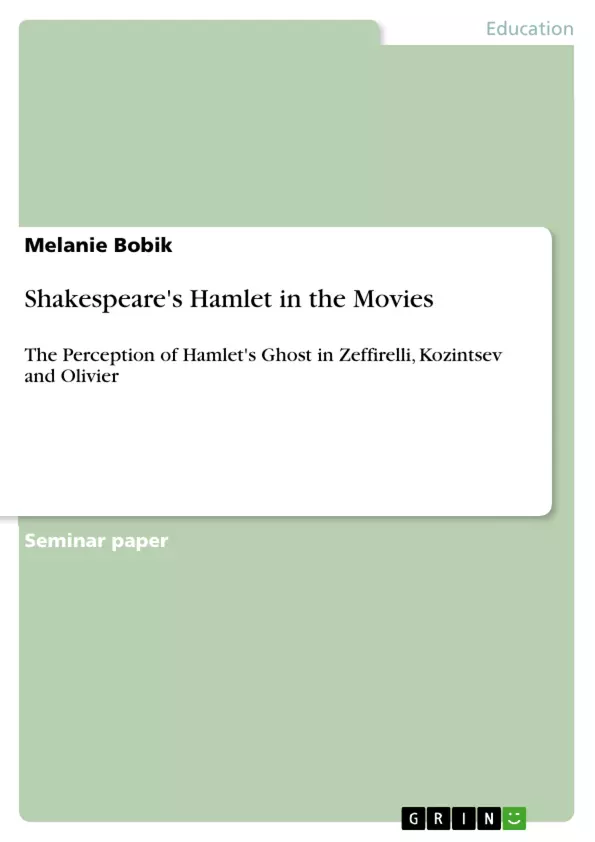Shakespeare’s Hamlet, „the Mona Lisa of literature“, features a supernatural element that launches the tragedy: the ghost of Denmark’s murdered king. Ever since the play was staged, the Ghost’s true nature and his function in the play have been much discussed issues. Obviously, the playwright used people’s uncertainty about the ghost-lore of his time to deliver a play that remains opaque until today.
Film makers like Zeffirelli, Olivier and Kozintsev have dealt with the Ghost’s identity in different ways and show the essential position of it within the play. One created an abusive father who comes back to seek revenge. The other one presents a rather political reading of the Ghost. In the 3rd movie under investigation the Ghost conveys the message that family values must be remembered in order to maintain a society.
This paper analyses the different views, theological and philosophical ones, and provides more than 30 bibliographical sources for further reading and research.
Inhaltsverzeichnis (Table of Contents)
- Introduction
- Historical Background - Elizabethan ghost-lore
- Catholic Concept of Demonology
- The Catholic Doctrine of Purgatory
- The Protestant Conception of the Spirit World
- Damned or Saved
- The Protestant Devil
- Reginald Scot and his Discoveries of Witchcraft
- Catholic Concept of Demonology
- The Reception of a Ghost on Elizabethan Stage
- The Revenge Ghost
- Ghosts in Shakespeare's Plays
- Hallucinations, Dreams and Paintings of the Subconscious
- The Ghost in Hamlet - Where does He Come from?
- Catholic and Protestant Debates
- Psychological and Philosophical Approaches
- Hamlet's Ghost in the Movies
- Laurence Olivier's Hamlet
- The Abusive Father
- Olivier's Closet Scene
- Revenge, not Remembrance
- Grigor Kozintsev's Hamlet
- A Ghost Clad in Iron
- Time is out of Order
- Remember Me
- The Weight of History
- A Ghost Clad in Iron
- Franco Zeffirelli's Hamlet
- A Father Returns
- „Ghostus Interruptus“
- Italian Family Values
- Laurence Olivier's Hamlet
Zielsetzung und Themenschwerpunkte (Objectives and Key Themes)
This paper examines the various interpretations, both theological and philosophical, of Hamlet's ghost, focusing on its representation in three films from different decades. The paper explores the historical background of Elizabethan ghost-lore, delving into the Catholic and Protestant conceptions of the spirit world and the role of magic and witchcraft in Elizabethan society. By analyzing the ghost's portrayal in films by Olivier, Kozintsev, and Zeffirelli, the paper aims to shed light on the evolving understanding of Hamlet's ghost in different cinematic contexts.
- The role of Hamlet's ghost in Shakespeare's play and its various interpretations
- The historical and religious context of Elizabethan ghost-lore, including Catholic and Protestant perspectives
- The influence of the Elizabethan era on the reception of ghosts and the supernatural
- The cinematic portrayals of Hamlet's ghost and their interpretations in films by Olivier, Kozintsev, and Zeffirelli
- The evolving understanding of Hamlet's ghost in different cinematic contexts
Zusammenfassung der Kapitel (Chapter Summaries)
The introductory chapter delves into the ambiguity surrounding Hamlet's ghost, highlighting the ongoing debates surrounding its true nature and function within the play. This ambiguity is attributed to the supernatural element that propels the tragedy. The chapter emphasizes the importance of considering diverse perspectives, including theological and philosophical ones, in understanding the ghost.
Chapter two provides a historical context for Elizabethan ghost-lore, exploring the shifting landscape of beliefs during a period of scientific and religious transition. It examines the Catholic concept of demonology and purgatory, highlighting the belief in ghosts as either demonic entities or souls undergoing purification. The chapter then turns to the Protestant perspective, contrasting it with the Catholic view and exploring the Protestant devil and the role of temptation in the spirit world. This chapter concludes with a discussion of Reginald Scot's views on magic and witchcraft, contrasting them with the prevailing beliefs of King James I.
Chapter three focuses on the reception of ghosts on the Elizabethan stage, with a particular emphasis on the revenge ghost. It delves into the role of ghosts in Shakespeare's plays, examining how they were interpreted in light of the prevailing cultural and religious beliefs. The chapter then explores the ghost in Hamlet specifically, examining the influence of Catholic and Protestant debates on its interpretation.
Chapter four delves into the cinematic portrayals of Hamlet's ghost, starting with Laurence Olivier's adaptation. It analyzes how Olivier's interpretation of the ghost highlights themes of the abusive father and revenge. The chapter then moves on to Grigor Kozintsev's adaptation, exploring its portrayal of the ghost as a figure who embodies the weight of history and the concept of time out of order. Finally, the chapter examines Franco Zeffirelli's adaptation, focusing on its depiction of the ghost as a father figure who returns to guide his son.
Schlüsselwörter (Keywords)
This paper focuses on the themes of Elizabethan ghost-lore, supernatural elements in literature and film, the portrayal of Hamlet's ghost in different cinematic adaptations, the influence of historical and religious contexts on the interpretation of ghosts, and the evolving understanding of Hamlet's ghost throughout different eras.
- Citar trabajo
- Magister Artium Melanie Bobik (Autor), 2002, Shakespeare's Hamlet in the Movies, Múnich, GRIN Verlag, https://www.grin.com/document/149185



